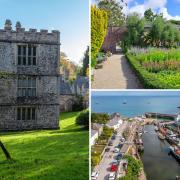Dame Barbara Hepworth has her first major London retrospective at Tate in 50 years. EWEN MACDONALD revisits her St Ives studio and gardens

Dame Barbara Hepworth quietly worked away in her St Ives studio for more than 35 years. Ahead of her first major London retrospective for 50 years at Tate. EWEN MACDONALD revisits her St Ives studio and gardens
There is an old art school joke that sculpture is something you bump into when you are trying to get a more expansive view of the painting you are gazing at.
The experience of sculpture is different to the two dimensional space of painting. It is a physical impediment for us to traverse. It is very real. It has a rigid form that must be circumnavigated. Its materials are made of identifiable physical substances; clay, plaster, wood, steel, bronze, stone, marble, concrete. Their scale can easily intimidate us. Their very function in our personal space can overwhelm us.

The sculptor Barbara Hepworth’s achievements as an artist are phenomenal, especially considering that she was both female and British, both of which were under suspicion by the international art fraternity for much of the 20th Century.
A sojourn around her former studio in St Ives, now owned by the Tate, on a cold and bright January day enlightens me as to just how great she was.
The main indoor gallery has a strange resonance to it, as though the sculptures on display are objects left behind as a kind of momento mori by another civilisation revealing the future as past. A civilisation which we have just discovered and must somehow interpret without the means of any anthropological guide. We must feel our way though the objects on display using only our senses. The overall effect of the installation of these sculptures reminded me of the giant, black monolith in Stanley Kubrick’s 1968 film 2001: A Space Odyssey.

Hepworth’s work appears to have been progressing in a different direction before her death, not uncommon for artists, the forms, still abstract, but noticeably more figurative as in Oval with Two Forms 1971. Which has two figures apparently set upon a kind of proscenium arch and also with the piece Fallen Images 1974-5 all of whose component parts are rendered in marble.
Two Figures (Heroes) 1954 in which two abstracted figurative forms are produced in oil paint, prove that Barbara Hepworth could mix it up with the St Ives boys in the medium of painting. I loved the wayward pencil marks: a true joy of seeing art up close and personal in observing the method of the making.
In the garden there is much to delight the senses. First of all was the 1973 polished bronze sculpture Shaft and Circle a Picasso-esque cubist guitar shaped into its most essential components and now made irreducible. In Figure for Landscape’ 1960 the figure and the landscape have been combined into a single form perfectly reflecting both elements like some Joycean portmanteau from Finnegans Wake. The holes in the body felt like wounds carved into the Cornish landscape by the mighty and irrepressible Atlantic Ocean.
Four-Square Walk Through’ from 1966 has four bronze slabs set atop of one another in a totemic sculpture. There are circular intersections cut into the blocks which feminises them. These are not the heaving masculine forms of Richard Serra, nor the apocalyptic mass of ruin at Anselm Kiefer’s Barjac studio in Southern France. Four-Square has a more open and welcoming quality to it: more Penwith than Buchenwald.
In Hollow Form with Inner Form’ 1968 there appears to be a sexual edge as though two forms have merged in a kind of abstract artistic intercourse. The result of which coupling could easily have produced an artwork such as Sphere with Inner Form’ 1963 a sculpture seemingly pregnant with another sculpture.
The sculptures on display are not all round and smooth Garden Sculpture (Model for Meridian)’1958 consists of torn and splayed strands of bronze endlessly repeating themselves in an infinite arabesque.
My favourite piece in the collection was Two Forms (Divided Circle)’1969 with its male and female forms rendered in the female vernacular it is a lyrical and romantic poem, gilded from the gods, an image which should be almost impossible to capture in the abstract and with such a heavy hardened, though nonetheless tactile, material as bronze.
That Hepworth’s work is feminine in form is undeniable and it brings with it great inner and outer strength, grace, poise and beauty. But they are hard fought for and hard won. Hepworth was no shrinking violet her materials, her craftsmanship and her hard graft are all too evident.
Nobody knows how anybody will be regarded by future generations, even Shakespeare’s legacy has gone through its ups and downs over the centuries.
Though I think what we can definitely ascribe to Barbara Hepworth is that she was a British artist who deserves to hold her seat at the table of great 20th Century artists.
This article first appeared in Cornwall Life February 2015.



























